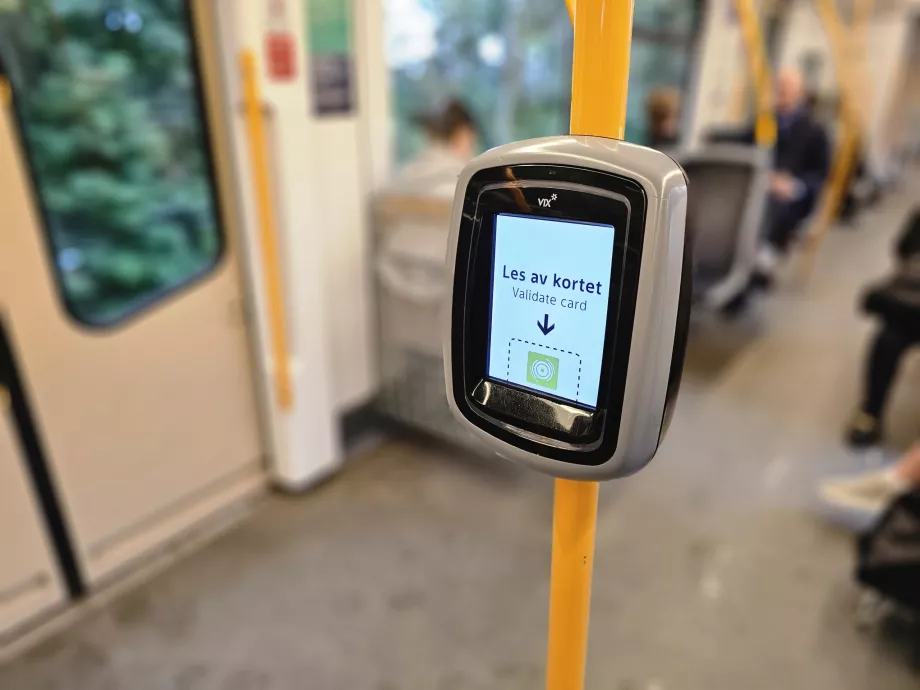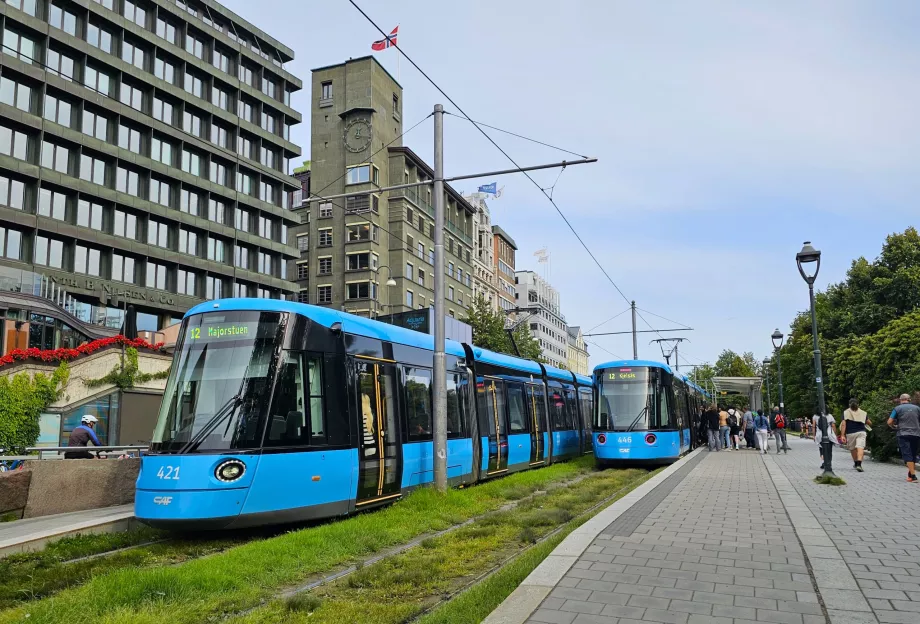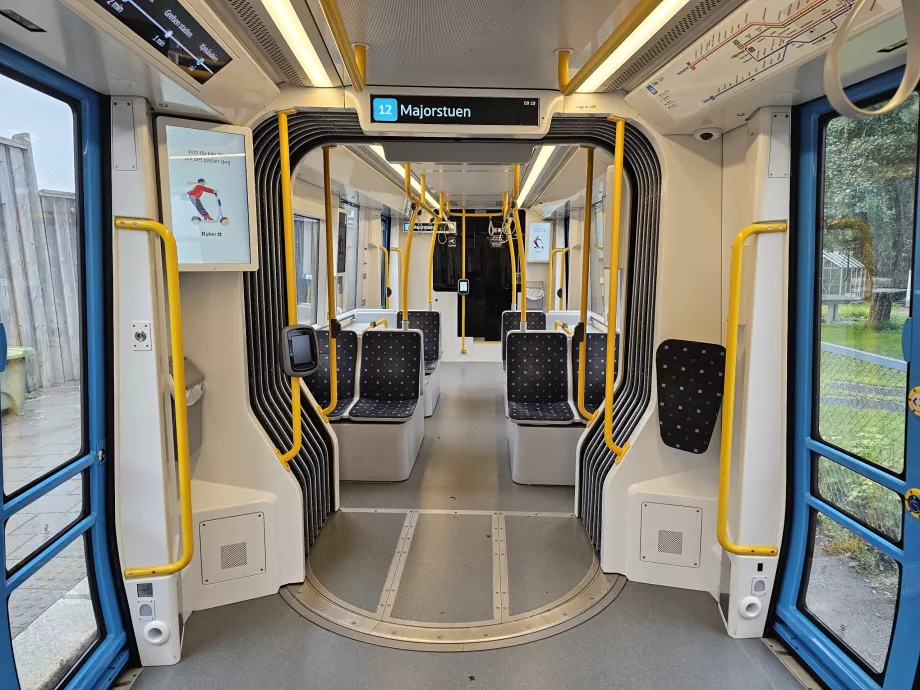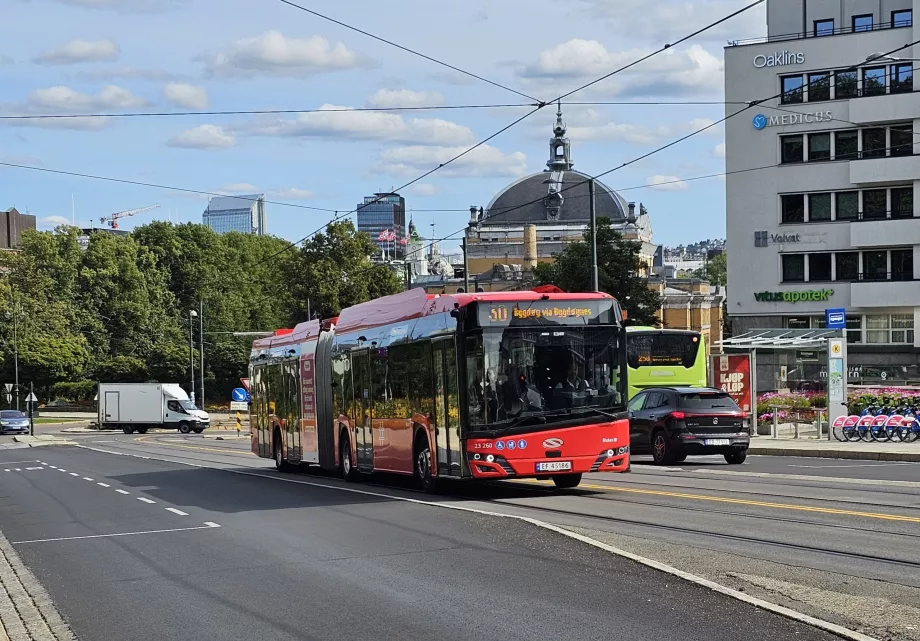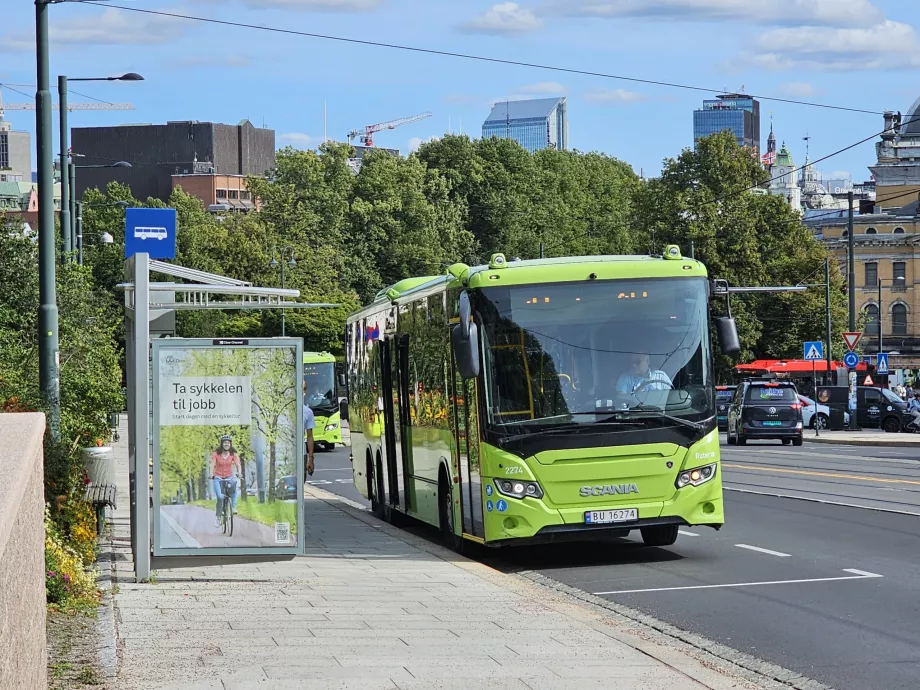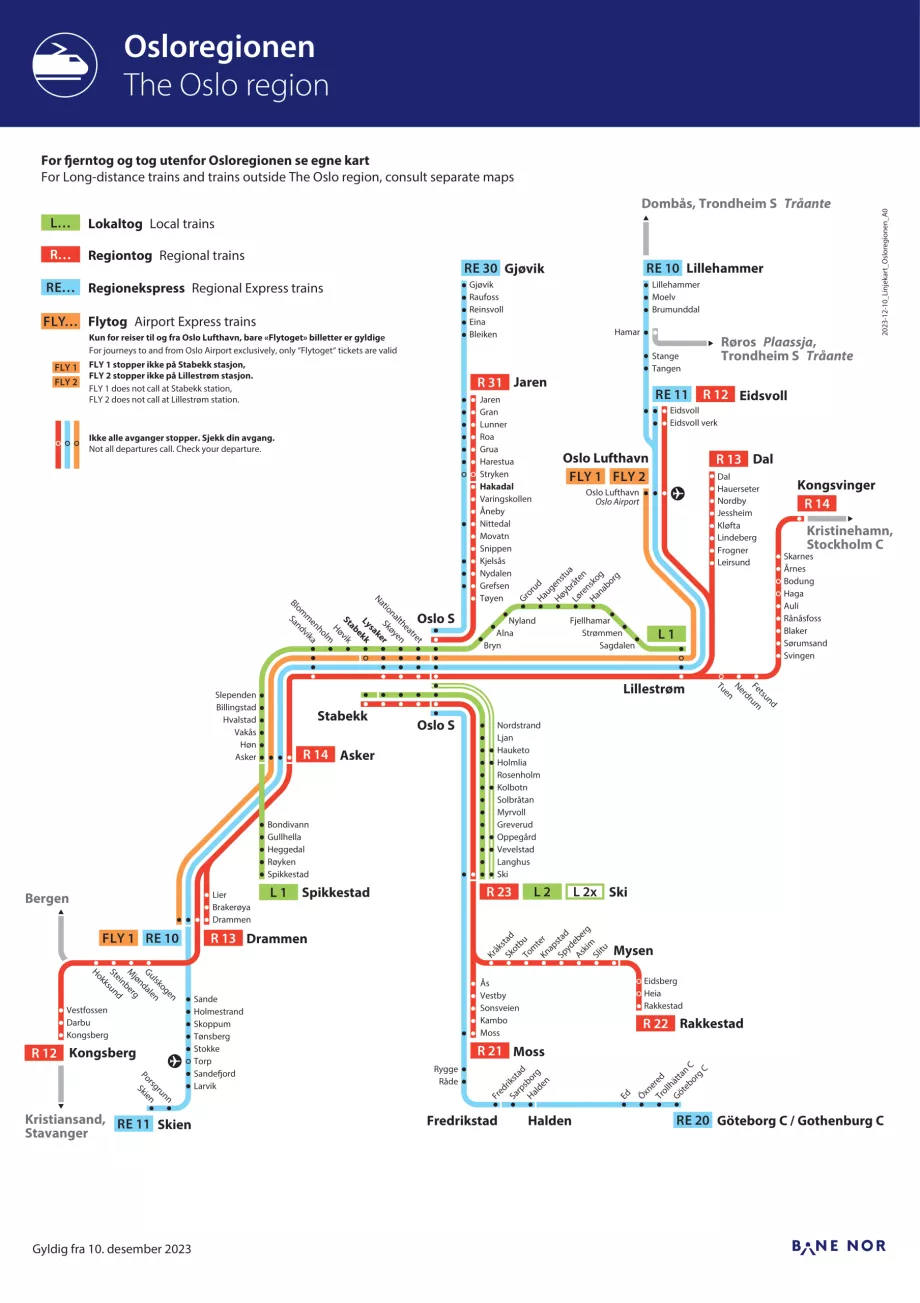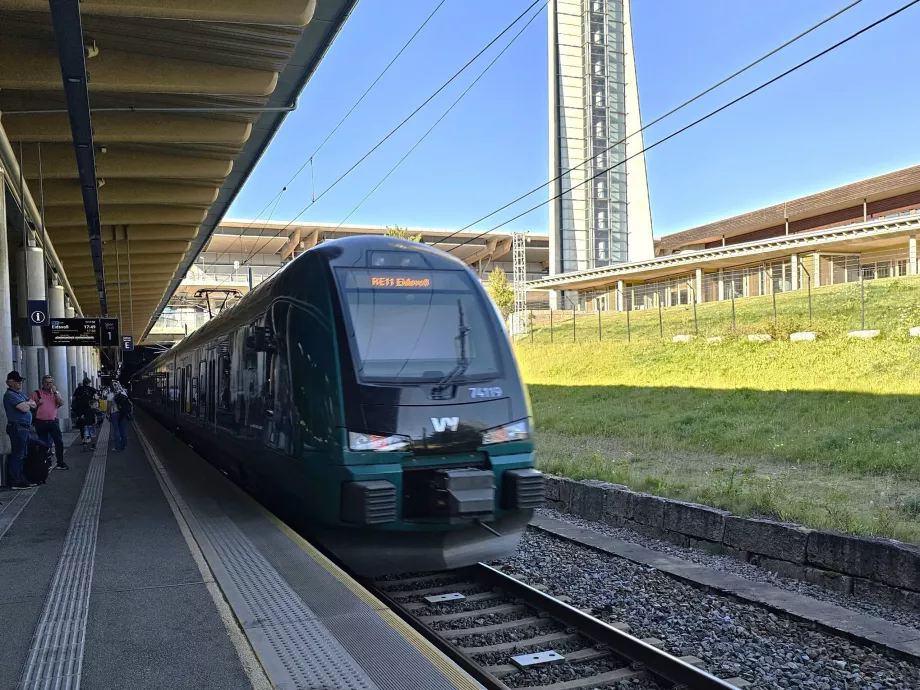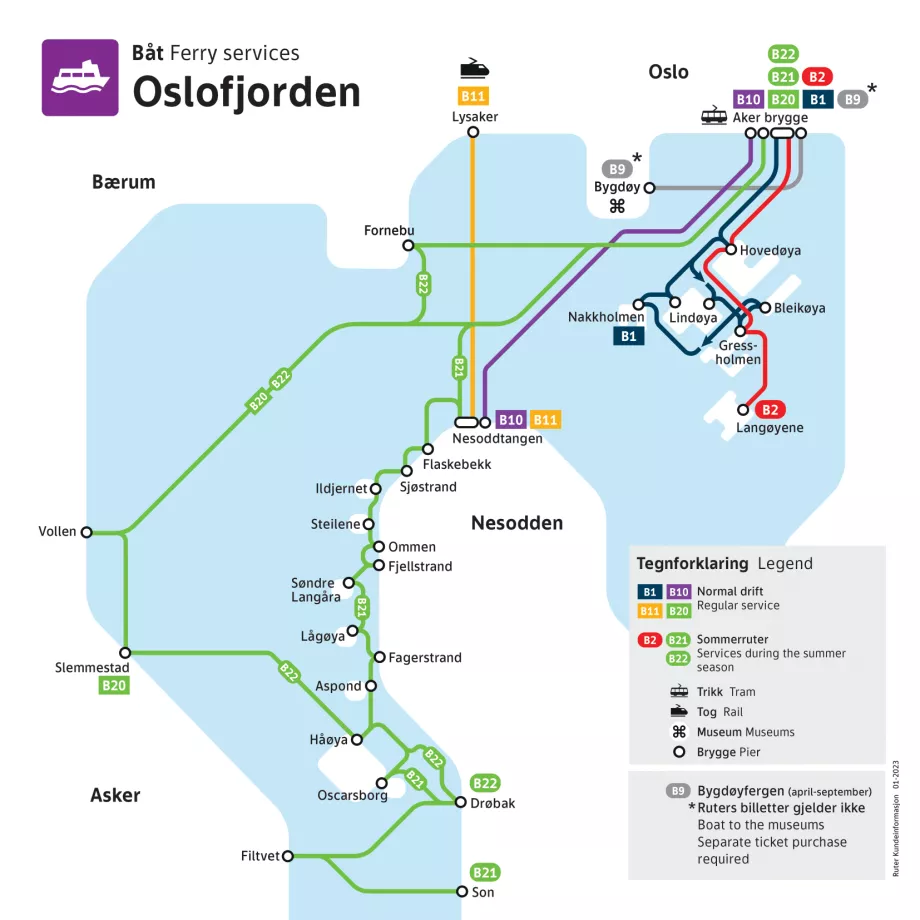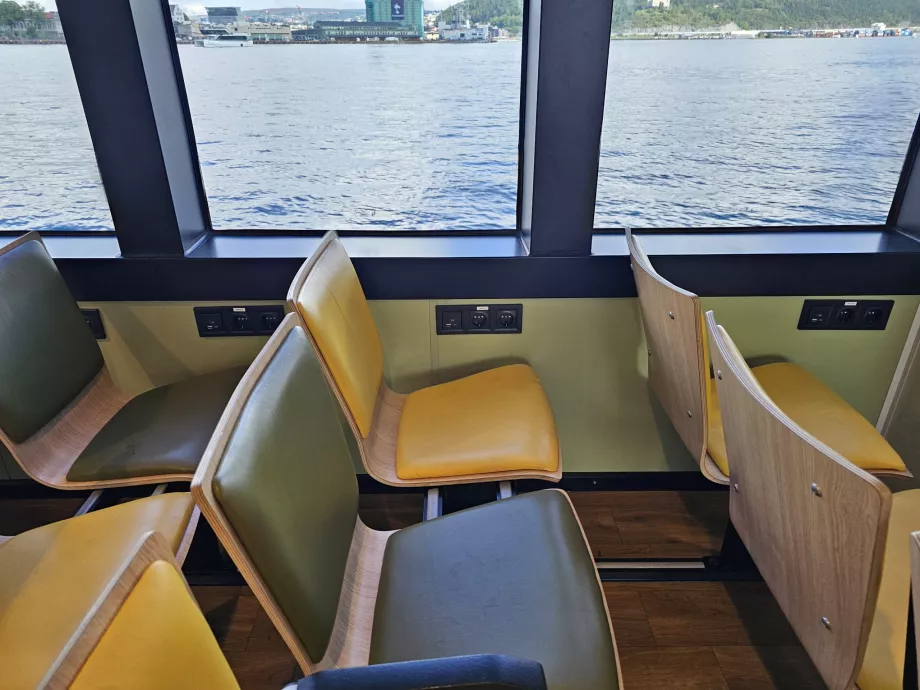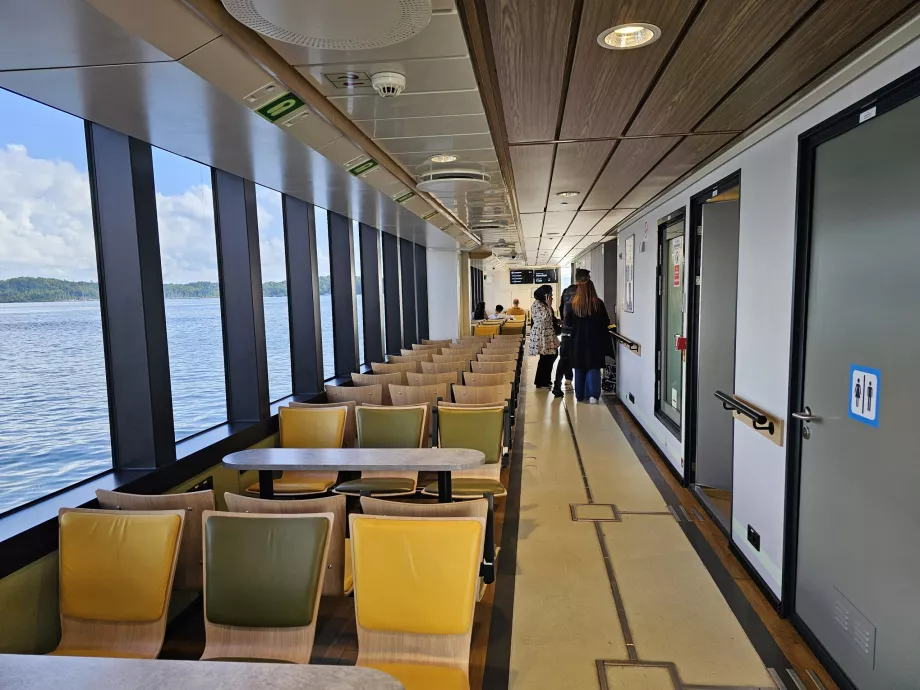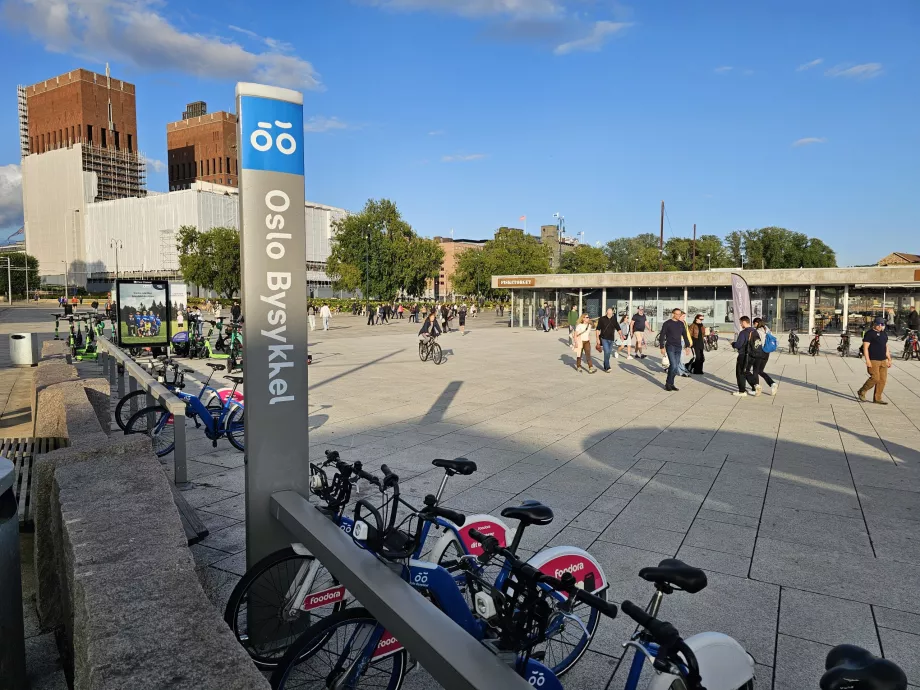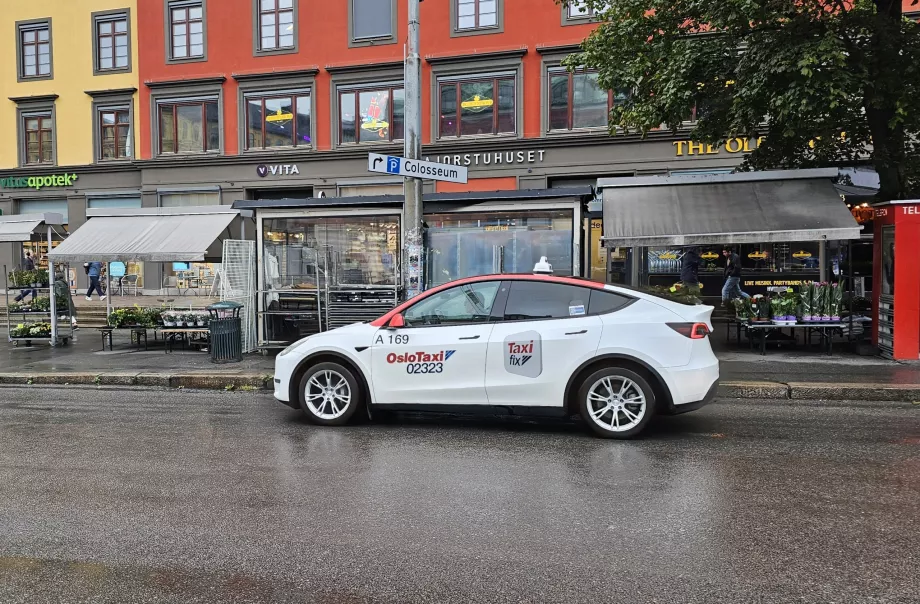Getting around Oslo

Oslo's public transport is run by Ruter, which operates the metro, trams, buses and ferries, and Vy's regional trains.
Travelling around Oslo by public transport is fast, safe and relatively cheap. One ticket costs 42 nok and a day ticket, for example, costs 127 nok.
We break down the tickets and the different modes of transport in detail below.
Book your hotel in Oslo in advance
Tickets for public transport
The whole of Oslo is in Zone 1, so you don't have to worry about other zones.
In addition, all metro, tram and red bus lines are in Zone 1, which in some places go beyond Oslo's administrative boundaries. Nevertheless, a ticket to Zone 1 (e.g. Bekkestua, Østerås) will suffice for these cases.
Airport Oslo OSL falls in zone 4. If you travel to/from the airport at least twice within 24 hours and then at least once in the city, it is worth buying a 24-hour ticket for all zones.
Ticket prices
The table below shows the prices of the most commonly used tickets. For the latest prices and the full range, visit the official website at ruter.no/tickets-and-fares.
| Validity | Price - 1 zone | Price - 4 zones | |
|---|---|---|---|
| Single ticket | 60 minutes | 42 nok - adults 16,80 nok - 6-17 years 21 nok - Seniors over 67 years old |
124 nok - adults 48 nok - 6-17 years 60 nok - seniors over 67 years old |
| 24-hour ticket | 24 hours | 127 nok - adults 64 nok - 6-17 years 64 nok - Seniors over 67 years old |
291 nok - adults 146 nok - 6-17 years 146 nok - seniors over 67 years old |
| 7-day ticket | 168 hours | 352 nok - adults 177 nok - 6-17 years 177 nok - seniors over 67 years old |
852 nok - adults 426 nok - 6-17 years 426 nok - seniors over 67 years old |
A weekly ticket is worthwhile for a 3-day stay if you would use more than 3 single tickets each day.
The easiest way to purchase additional zone tickets, if you have a day pass for Zone 1 only for example, is via the Ruter mobile app. Simply enter the location you want to go to and the app will automatically recommend you to buy a ticket.
In this case, you pay 27 nok for the ride to the next zone.
For example, if you have a day ticket for 1 zone for 127 kroner and are heading to Oslo-Gardermoen Airport in the evening, don't buy an airport ticket at the machine for 124 nok, but buy the remaining fare in the mobile app for 109 nok.
Where to buy tickets?
You can buy tickets for public transport in two ways:
Mobile app Ruter
You can download the official app via Google Play / App Store.
You pay for the ticket, activate it through the app at the time you choose and then you don't have to deal with anything.
You do not need to attach the ticket to the validator. Just show it at the random transport check.
Chip ticket
You can still buy a classic paper ticket with a chip.
There are no longer any ticket machines in Oslo, but you can buy tickets at all 7-Eleven, Deli De Luca, Narvesen and Mix stores. The paper ticket must always be attached to the validator before entering a metro or train station or inside metro, tram, bus, boat cars.
In Oslo, you can't pay fares with your own contactless card.
Connection finders
What are the best websites to find connections between stops in Oslo?
You can find all metro, train, tram, bus and boat connections via the official transport company websites.
You can find timetables for each line in pdf format only in Norwegian at this page: ruter.no/rutetabeller-og-linjekart.
Maps of all lines can be found at: ruter.no/route-maps.
Current connections and departure times of all transport in Oslo are also well provided by google.com/maps.
Metro
Oslo has a total of 5 metro lines. In the central part of the city, between Majorstuen and Tøyen stations, all lines run together and form a very busy spine route under the historic centre.
The metro in Oslo provides convenient transport to the mountains, ski areas or hiking trails.
For detailed information on how to use metro tickets, where to find line maps or what the timetables are, see the separate chapter - Oslo Metro.
Trams
Oslo has a good tram system, which passengers can use on 6 lines.
The typical blue trams are great to use when travelling around the city centre, but also to outlying areas where you may come across cheaper accommodation.
Travelling on the trams is fast and very clear. All stops are equipped with electronic departure time indicators.
The following tram routes are the most useful for tourists:
- Line 12 - starts at one of the main metro interchanges Majorstuen and continues via Vigelandsparken, Aker brygge (ideal for visiting Nasjonalmusset, Nobel Peace Centre, Tjuvholmen Island, Akershus Fortress or the Town Hall) to the Opera House and the main train station. It continues northwards and follows the course of the Akerselva River for about 200-300 metres.
- Lines 11 and 13 - run through the city centre between the main train station and the Nationaltheatret station, where you can visit the Royal Palace
You can always use all doors to get on and off the tram.
Timetables and map
For a map of tram routes in Oslo, please visit this page: ruter.no/route-maps.
All tram lines have the following parameters:
- Weekdays - frequency during the day 10 to 12 minutes, late evening 15 to 20 minutes; operation from approx. 5:30 to 1:15
- Weekends - frequency 15 to 20 minutes; operation from approx. 6:30 to 1:15
- Detailed timetable: ruter.no/rutetabeller-og-linjekart/trikk/
Buses
Buses complement the metro and tram network and are particularly useful for the outskirts of Oslo.
There are two types of buses in Oslo.
- Red - city lines whose routes run entirely within Zone 1.
- Boarding and alighting is possible through all doors
- Green - suburban lines, which always run from Zone 1 to towns and villages outside Oslo or purely around Oslo without going directly into the centre
- Boarding is only possible through the front door, where you show the driver a ticket from the mobile app or a paper ticket purchased in advance
- The driver also sells tickets for these connections, but at an additional cost 20 nok
For tourists, the following bus lines are the most useful:
- Line 30 - runs through the centre and goes to the Bygdøy Peninsula Museum.
- Line 41 - runs from Røa metro station to the Wyller ski area
- Line 48 - runs from Voksenkollen metro station to Tryvann ski area
Timetables and map
For a map of bus routes in Oslo, please visit this page: ruter.no/route-maps.
City buses passing through the centre on busy routes have an interval of 10-15 minutes on weekdays and 15-30 minutes on weekends.
- Detailed timetables of city buses: ruter.no/rutetabeller-og-linjekart/bybuss
- Detailed timetables for suburban buses: ruter.no/rutetabeller-og-linjekart/buss
Trains
For quick transport around the city, you can also use Vy's regional train lines.
Ruter tickets are not valid on the long-distance Vy, Go-Ahead, SJ and Flytoget express trains to the airport.
You can use Ruter tickets on the L1, L2, RE10, RE11, R12, R13, R14, RE20, R21, R22, R23, RE30, R31 lines.
The following train stations are located within zone 1:
- Oslo S -> westbound: Nationaltheatret, Skøyen, Lysaker, Stabekk
- Route Oslo S -> direction Lillestrøm: Bryn, Alna, Grorud, Haugenstua, Høybråten, Lørenskog
- Route Oslo S -> direction Ski: Nordstrand, Ljan, Hauketo, Holmlia, Rosenholm
- Route Oslo S -> direction Gjøvik: Tøyen, Grefsen, Nydalen, Kjelsås, Snippen, Movatn
Frequented routes
Trains practically replace the metro for getting from the centre to the western suburbs of Oslo. Trains run every 2-6 minutes on the Oslo S - Nationaltheatret - Skøyen - Lysaker - Stabekk - and onwards towards Drammen.
There are also frequent services to Oslo Gardermoen Airport (lines RE10, RE11, R12).
The easiest way to find connections and timetables is on the Ruter.no website.
Tickets
Tickets purchased via the Ruter mobile app can be carried on your mobile phone and presented to the conductor.
Ruter chip tickets purchased at newsagents must be activated by attaching them to a reader on the platform.
Paper tickets purchased from vending machines do not need to be marked in any way and again, you just need to present them to the conductor at the check.
Ferries
The boat services incorporated into the public transport network include several ferry lines, all of which depart from the central Aker brygge pier.
The ferries sail to the picturesque islands in the Oslofjord, all of which are in Zone 1, so you don't need to pay extra for a ferry ride on top of your day ticket: Hovedøya, Lindøya, Gressholmen, Langøyene, Nakkholmen and Bleikøya.
Book a hotel with a view of the fjord
There are two ferry lines to these islands:
- B1 - year-round route sailing once every 20 minutes in summer and once every hour in winter, serving all islands except Langøyene
- B2 - summer seasonal route sails 1x every 30 minutes and serves the islands of Hovedøya, Gressholmen and Langøyene
Another busy year-round service sailing 1x every 30 minutes connects the town of Nesoddtangen on the peninsula:
- B10 - Aker brygge
- B11 - Lysaker
Nesoddtangen is already in zone 2, so if you have a day ticket for zone 1, you have to pay extra via the Ruter mobile app 27 nok.
The lightly frequented lines B20, B21 and B22 are also part of Ruter and sail to points in zones 2, 3 or 4.
You can find connections and buy tickets via ruter.no.
Line B9, which connects Aker brygge to the Bygdøy museum peninsula, is not included in the public transport system and you must purchase a fare on board at 79 nok (can only be paid by card).
The ferries are equipped with both indoor and outdoor decks that offer spectacular views of the islands and the centre of Oslo.
Inside the ferry you will find outlets or toilets.
Shared bikes
If you're interested in a different, slightly faster and more active mode of transport than walking, you can rent a bike from the public and fairly busy bike racks for a small fee.
Oslo Bysykkel operates shared bikes.
To unlock a bike, you need to install the Oslo Bysykkel mobile app, through which you will then also pay for the ride.
The prices are as follows:
- 25 nok - 60 minutes on a manual bike; for an electric bike, the first 5 minutes of the ride are included and then 2,50 nok per minute.
- If you exceed one hour of riding, you will automatically be charged 15 nok for every 15 minutes you ride.
- The maximum rental time is 3 hours, after which the bike is locked
- 119 nok - 72-hour pass including always 180 minutes per ride. However, the number of rides within 72 hours is unlimited; for electric bikes only the first 2 minutes of the ride are always included, after that 2,50 nok per minute is counted.
- 169 nok - A 30-day pass including 60 minutes per ride; for electric bikes, only the first 2 minutes of the ride are included, after which 2,50 nok per minute counts
- Membership automatically renews and must be manually cancelled
Taxi
Despite the high prices, taxis are popular in Oslo and you will see plenty of them on the streets.
You can easily flag down a classic taxi on the street. Most taxi drivers only accept credit cards and not cash. Taxis are always metered and unfair behaviour by taxi drivers is absolutely rare in Oslo.
You can see the prices of regular taxis on the website of the largest taxi company in the city: oslotaxi.no/en/prices
The mobile apps Uber and Bolt are widely used in Oslo, and Bolt is usually cheaper. However, it's always worth comparing prices on both apps.
Any questions left?
If you have any questions or comments about the article...

